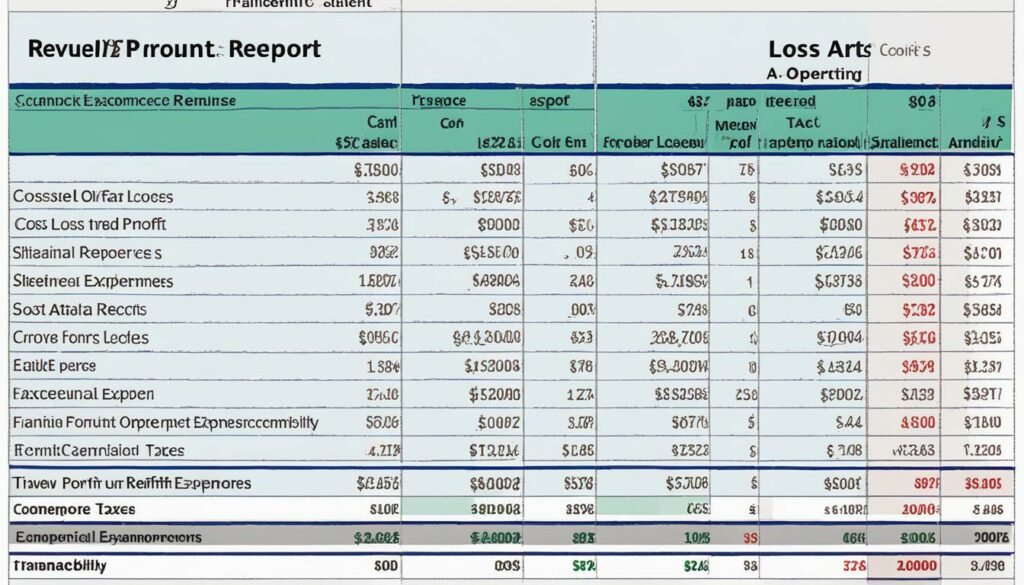A profit and loss statement, also known as a P&L statement or income statement, is a key financial document for ecommerce businesses. It provides a comprehensive overview of a company’s revenue and expenses over a specific period, such as a month, quarter, or year. The P&L statement is essential for tracking the financial health of an ecommerce business and making informed decisions about its operations. It includes important information such as operating income, gross profit, net operating profit, interest expenses, and net income.
Key Takeaways:
- A profit and loss statement is a financial document that summarizes a company’s revenue and expenses.
- It is essential for tracking the financial health of an ecommerce business and making informed decisions.
- The statement provides important information such as operating income, gross profit, and net income.
- Comparing income statements from different periods allows for analysis of changes and trends.
- The profit and loss statement is closely related to other financial metrics and statements such as the cash flow statement and balance sheet.
Understanding the Components of a Profit and Loss Statement
The profit and loss statement is a crucial financial document for ecommerce businesses. It provides a comprehensive overview of a company’s revenue and expenses during a specific period. Let’s take a closer look at the key components of a profit and loss statement:
1. Revenue
The revenue section represents the total income generated by the company. It includes sales revenue from products or services, as well as any other sources of income such as interest or royalties.
2. Cost of Goods Sold (COGS)
The cost of goods sold (COGS) includes the direct expenses associated with producing goods or delivering services. It includes costs such as raw materials, manufacturing expenses, and direct labor.
3. Operating Expenses
The operating expenses section includes all other expenses incurred in the day-to-day operations of the business. This can include marketing costs, employee wages, rent, utilities, office supplies, and administrative expenses.
Net Operating Profit
The net operating profit is calculated by subtracting the operating expenses from the gross profit. It reflects the company’s profitability after accounting for all operating expenses.
Interest Expenses
Interest expenses are the costs of borrowing money or using credit. This includes interest payments on loans, credit card interest, and other financing costs.
Net Income
Net income represents the final result of the profit and loss statement. It is calculated by subtracting all expenses, including interest expenses, from the total revenue. Net income indicates the overall profitability of the business.
Maintaining a clear and detailed profit and loss statement is essential for accurately assessing the financial performance of an ecommerce business. It allows business owners to identify areas of strength and areas that may need improvement. By analyzing the components of the profit and loss statement, businesses can make informed decisions to optimize their revenue and manage their expenses effectively.

Common Mistakes to Avoid in a Profit and Loss Statement
When preparing a profit and loss statement, it’s crucial to avoid common mistakes that can undermine the accuracy and usability of the financial document. By understanding these pitfalls, businesses can ensure reliable revenue reporting, maintain an organized chart of accounts, and accurately calculate the cost of goods sold (COGS) with an integrated inventory management system. Let’s explore the most common mistakes and how to avoid them.
Incorrectly Reporting Revenue
One of the most frequent errors in a profit and loss statement is incorrectly reporting revenue. Many businesses mistakenly record the total amount received without considering deductions such as credit card fees or shipping income. It is essential to segregate sales revenue from other transaction types for precise reporting. By tracking revenue separately, businesses can get a clear picture of sales performance and accurately analyze profitability.
Handling Chart of Accounts
A complete and organized chart of accounts is vital for proper expense classification and accurate financial analysis. Failure to maintain a comprehensive chart of accounts can lead to misclassification of expenses, resulting in incorrect insights and decision-making. By regularly reviewing and updating the chart of accounts, businesses can ensure that expenses are appropriately allocated and financial analysis is reliable.
Accurate Cost of Goods Sold (COGS)
The cost of goods sold (COGS) is a significant component of a profit and loss statement for businesses that sell products. A common mistake is failing to maintain accurate and up-to-date COGS figures. Regular stock counts and including all relevant details in the COGS calculation are essential for precise financial reporting. Integrating an inventory management system with the accounting software can streamline the process and ensure COGS accuracy, leading to more informed decision-making.
By avoiding these common mistakes, businesses can improve the accuracy and reliability of their profit and loss statements, enabling them to make informed financial decisions and effectively assess their overall performance.

| Mistake | Impact | Prevention |
|---|---|---|
| Incorrect Revenue Reporting | Overstated revenue and inaccurate profitability analysis | Separate sales revenue from other transaction types and track deductions accurately. |
| Chart of Accounts Mismanagement | Misclassification of expenses and incorrect financial analysis | Maintain a comprehensive and organized chart of accounts, regularly reviewing and updating it. |
| Inaccurate Cost of Goods Sold (COGS) | Distorted financial performance and inaccurate gross profit calculation | Conduct regular stock counts, include all relevant details in COGS calculation, and integrate inventory management system with accounting software. |
The Importance of Tracking a Profit and Loss Statement in Ecommerce
Tracking a profit and loss statement is crucial for ecommerce businesses, as it provides valuable insights into the financial health and overall performance of the company. By analyzing this statement, businesses can assess their profitability, make informed decisions, and set financial goals.
One of the key benefits of tracking a profit and loss statement is the ability to identify areas of profitability and loss. This statement outlines the revenue and expenses incurred by the business, allowing for a comprehensive analysis of daily operations and financial performance.
Comparing income statements from different periods provides a clear understanding of changes and trends in the business’s financial performance. By monitoring these changes, businesses can identify areas of improvement or potential risks, enabling them to make strategic decisions and optimize their operations.
Budgeting and Forecasting
The profit and loss statement serves as the foundation for budgeting and forecasting. By closely monitoring revenue and expenses, businesses can establish realistic budgets and forecast future financial outcomes. This allows for effective resource allocation and helps manage cash flow, ensuring the business remains profitable and sustainable in the long run.
Budgeting and forecasting are essential for making sound financial decisions, such as assessing the effectiveness of advertising campaigns, determining optimal shipping options, setting appropriate salary levels, making strategic hires, and managing inventory levels. The profit and loss statement provides the necessary data to evaluate the financial impact of these decisions and adjust accordingly.
Key Takeaways
- Tracking a profit and loss statement is crucial for assessing the financial health and performance of an ecommerce business.
- Comparing income statements from different periods helps identify changes and trends in the business’s financial performance.
- The profit and loss statement serves as the foundation for budgeting and forecasting, enabling businesses to make strategic decisions and set financial goals.
- Effective budgeting and forecasting aid in optimizing daily operations, managing cash flow, and ensuring long-term profitability.
Analyzing Your Ecommerce Business’s Income Statement
When it comes to understanding the financial performance of your ecommerce business, analyzing the income statement is crucial. By examining key trends and metrics, you can gain valuable insights into your business’s profitability and make informed decisions to drive growth. Let’s explore some important metrics you should consider:
Gross Profit and Gross Profit Margin
One essential metric to analyze is the gross profit and gross profit margin. Gross profit represents the profit made from each sale after deducting the production costs. This metric helps you assess the profitability of your products or services. The gross profit margin, expressed as a percentage, provides an even clearer picture by showing the proportion of gross profit relative to your revenue.
Net Operating Profit and Net Profit
Comparing your gross profit to your net operating profit and net profit is another valuable analysis. Net operating profit shows the profitability of your business after considering operating expenses. It helps you understand the impact of various expenses on your overall profitability. Net profit represents the final amount of profit generated after all deductions, including interest expenses and taxes.
Percentage Analysis
Percentages are powerful tools for analyzing specific expenses or categories as a percentage of your income. By calculating expense percentages, you can identify areas of your business that may be consuming a significant portion of your revenue. This analysis helps you pinpoint areas that need improvement or adjustment to optimize your overall profitability.
Take the time to review your income statement regularly and dig into the numbers to fully understand your ecommerce business’s financial performance. By doing so, you can make data-driven decisions to drive growth and improve your bottom line.

The Relationship Between the Profit and Loss Statement and Other Metrics
The profit and loss statement, also known as an income statement, is a crucial financial document for evaluating the performance of an ecommerce business. However, it is important to understand that this statement is closely linked to other financial metrics and statements, providing a comprehensive view of the company’s financial health and stability.
“The profit and loss statement, also known as an income statement, is a crucial financial document for evaluating the performance of an ecommerce business.”
One important metric that complements the profit and loss statement is revenue analysis. By analyzing revenue trends and patterns, businesses can gain valuable insights into their growth and performance. Revenue analysis helps identify the sources of revenue growth, allowing businesses to make informed decisions and implement strategies for further expansion.
The profit and loss statement also plays a significant role in assessing the profitability of each sale, as it provides insights into the company’s gross margin. The gross margin represents the percentage of revenue that exceeds the cost of goods sold. By calculating the gross margin, businesses can determine the effectiveness of their pricing strategies, cost of production, and overall profitability.
A crucial aspect of financial analysis is the cash flow statement. While the profit and loss statement focuses on revenue and expenses, the cash flow statement provides information about the movement of cash in and out of the business. It includes details about operating activities, investing activities, and financing activities, enabling businesses to evaluate their cash flow position and make strategic decisions accordingly.
In addition to the cash flow statement, the profit and loss statement is also closely related to the balance sheet. The balance sheet provides a snapshot of the company’s financial position at a specific point in time, including assets, liabilities, and equity. By comparing the data from the profit and loss statement and the balance sheet, businesses can evaluate their financial stability and make informed decisions regarding investments, loans, and future growth.
To summarize, the profit and loss statement is a vital component of financial analysis in ecommerce businesses. However, to fully assess the company’s financial health and performance, it is crucial to consider and analyze other metrics such as revenue analysis, gross margin, the cash flow statement, and the balance sheet.

| Metric | Description |
|---|---|
| Revenue Analysis | Analyzing trends and patterns related to revenue growth and performance. |
| Gross Margin | Percentage of revenue that exceeds the cost of goods sold, indicating profitability. |
| Cash Flow Statement | Provides insights into the movement of cash in and out of the business. |
| Balance Sheet | Snapshot of the company’s financial position at a specific point in time. |
Challenges and Considerations in Preparing a Profit and Loss Statement
Preparing a profit and loss statement can be a complex task for businesses, as it entails several challenges and considerations that must be addressed. One of the primary challenges is maintaining accurate and up-to-date financial documentation. It is crucial to ensure that all revenue and expenses are properly recorded and classified to provide an accurate reflection of the company’s financial performance.
Utilizing accounting software can greatly streamline the process of preparing a profit and loss statement and improve accuracy. These software solutions offer features such as automated data entry and categorization, allowing businesses to efficiently track and record their financial transactions. By leveraging accounting software, companies can minimize errors and ensure the reliability of their profit and loss statements.
Furthermore, businesses should also take into account the specific requirements for financial analysis and reporting. This is particularly important when attracting investors or applying for business loans. Lenders and investors often rely on accurate financial statements, including the profit and loss statement, to assess the company’s financial health and viability. Therefore, it is essential to thoroughly review and validate the statement to meet the necessary standards and expectations.
A well-prepared and accurate profit and loss statement serves as a valuable tool for assessing financial performance and making strategic decisions. It provides insights into revenue streams, expenditure patterns, and overall profitability, helping businesses identify areas of improvement, cost-saving opportunities, and potential growth strategies. By overcoming the challenges associated with preparing a profit and loss statement and ensuring its accuracy, companies can effectively monitor their financial performance and pave the way for future success.
FAQ
What is a Profit and Loss Statement in Ecommerce?
A profit and loss statement, also known as a P&L statement or income statement, is a key financial document for ecommerce businesses. It provides a comprehensive overview of a company’s revenue and expenses over a specific period.
How can I understand the components of a Profit and Loss Statement?
The components of a profit and loss statement include revenue, expenses, cost of goods sold, operating expenses, net operating profit, interest expenses, and net income.
What are common mistakes to avoid in a Profit and Loss Statement?
Common mistakes to avoid include incorrectly reporting revenue, not maintaining a complete and organized chart of accounts, and not ensuring accurate and up-to-date cost of goods sold (COGS).
Why is tracking a Profit and Loss Statement important in Ecommerce?
Tracking a profit and loss statement is crucial for assessing the financial health and overall performance of an ecommerce business. It helps make informed decisions, set financial goals, and analyze changes and trends.
How can I analyze my Ecommerce Business’s Income Statement?
Analysis involves examining key trends and metrics such as gross profit, gross profit margin, net operating profit, and net profit to gain a better understanding of financial performance.
How is the Profit and Loss Statement related to other financial metrics?
The profit and loss statement is related to other financial metrics such as revenue analysis, gross margin, cash flow statement, and balance sheet, which together help assess financial health and make informed decisions.
What are the challenges and considerations in preparing a Profit and Loss Statement?
Challenges include maintaining accurate financial documentation, utilizing accounting software, and meeting specific requirements for financial analysis and reporting.
